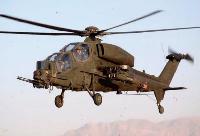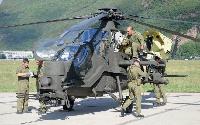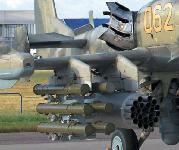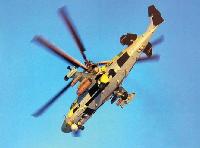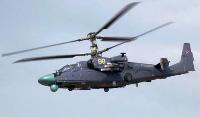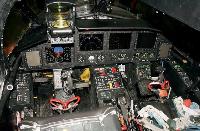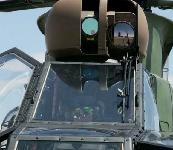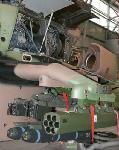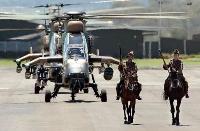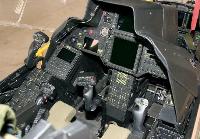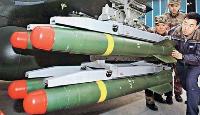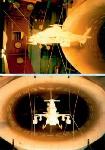Фотографии
-
The sleek and small silhouette of the Mangusta is highlighted in this frontal shot. Note the asymmetric configuration with a fuel tank on the right and a TOW twin launcher on the left.
Самолёты на фотографии: Agusta A-129 Mangusta - Италия - 1983
-
Two Mangustas at Bolzano ready to take off for a training mission in the Alps in preparation of an Afghan deployment.
Самолёты на фотографии: Agusta A-129 Mangusta - Италия - 1983
-
Самолёты на фотографии: Agusta A-129 Mangusta - Италия - 1983
-
A pair of Mangustas in flight in Alpine valleys during preparation for an Afghan deployment.
Самолёты на фотографии: Agusta A-129 Mangusta - Италия - 1983
-
An A129C firing a salvo of flares with the SIAP system.
Самолёты на фотографии: Agusta A-129 Mangusta - Италия - 1983
-
An A129C from Task Force 'Fenice' at Herat in 2011, before taking off for an escort mission.
Самолёты на фотографии: Agusta A-129 Mangusta - Италия - 1983
-
Close-up on the M197 20mm three-barrel cannon of the A129C, a very effective weapon which is fed by 300 rounds.
Самолёты на фотографии: Agusta A-129 Mangusta - Италия - 1983
-
A Mangusta at a forward arming and refuelling point (FARR) in ‘the middle of nowhere' in Afghanistan.
Самолёты на фотографии: Agusta A-129 Mangusta - Италия - 1983
-
An A129C at take-off. Note the compact dimensions of the helicopter.
Самолёты на фотографии: Agusta A-129 Mangusta - Италия - 1983
-
Самолёты на фотографии: Agusta A-129 Mangusta - Италия - 1983
-
Two A129Cs in flight over Afghanistan. They are in full combat long-range configuration - with the M197 chin gun loaded, external fuel tanks, full self-defence suite including SIAP and other systems and IR suppressors at the engine exhausts.
Самолёты на фотографии: Agusta A-129 Mangusta - Италия - 1983
-
Pilots and technicians around an A129C after a training mission in an Alpine environment.
Самолёты на фотографии: Agusta A-129 Mangusta - Италия - 1983
-
The first two Tigers were handed over to the Army at Oakey in December 2004, pictured here with the other two operational helicopter types at the time, the S-70A-9 Black Hawk and CH-47D Chinook.
Самолёты на фотографии: Boeing-Vertol CH-47 Chinook - США - 1961Eurocopter PAH-2 / EC.665 Tiger - International - 1991Sikorsky UH-60 Black Hawk / S-70 - США - 1974
-
An AH-1Z Viper from Marine Medium Helicopter Squadron 364 hovers above the flight deck of the USS Peleliu during an interoperability training exercise off the coast of Southern California.
Самолёты на фотографии: Bell AH-1W / AH-1Z Super Cobra - США - 1983
-
Самолёты на фотографии: Bell AH-1W / AH-1Z Super Cobra - США - 1983
-
Sailors prepare to fuel a AH-1Z Viper on the flight deck of the USS Peleliu.
Самолёты на фотографии: Bell AH-1W / AH-1Z Super Cobra - США - 1983
-
AH-1Z Vipers with Marine Medium Helicopter Squadron 268 aboard USS Makin Island.
Самолёты на фотографии: Bell AH-1W / AH-1Z Super Cobra - США - 1983
-
Самолёты на фотографии: Bell AH-1W / AH-1Z Super Cobra - США - 1983
-
The AH-1Z is armed with a three barreled M197 20mm cannon with a firing rate of 730 rounds per minute.
Самолёты на фотографии: Bell AH-1W / AH-1Z Super Cobra - США - 1983
-
Based at MCAS Camp Pendleton, California, Marine Light Attack Helicopter Training Squadron 303 (HMLAT-303) 'Atlas' is the AH-1Z training unit.
Самолёты на фотографии: Bell AH-1W / AH-1Z Super Cobra - США - 1983
-
The first Ka-52 prototype undergoing ship compatibility trials from the deck of the anti-submarine warfare ship Admiral Kulakov underway in the Barents Sea.
Самолёты на фотографии: Камов Ка-52 Аллигатор - Россия - 1997
-
A pair of early-production Ka-52s operated by the Russian Army Aviation's Torzhok training centre
Самолёты на фотографии: Камов Ка-52 Аллигатор - Россия - 1997
-
Самолёты на фотографии: Камов Ка-52 Аллигатор - Россия - 1997
-
The Ka-52 cockpit is protected by two layers of steel armour on the fuselage and armour plates on the sides of the canopy.
Самолёты на фотографии: Камов Ка-52 Аллигатор - Россия - 1997
-
The Ka-52 boasts a NPPU-80 limited-movement gun turret with a dual-feed Shipunov 2A42 30mm cannon and 460 rounds.
Самолёты на фотографии: Камов Ка-52 Аллигатор - Россия - 1997
-
The two-seat Ka-52 is the most advanced of the three attack rotorcraft types entering service with the RAA.
Самолёты на фотографии: Камов Ка-52 Аллигатор - Россия - 1997
-
By mid-2013 Ka-52s were in service with two RAA front line units at Chernigovka (575th Air Base) and Korenovsk (393rd Air Base), and the combat training centre at Torzhok. This example is painted in the new standard overall grey camouflage.
Самолёты на фотографии: Камов Ка-52 Аллигатор - Россия - 1997
-
The Ka-52 fuselage is built around a steel torsion box beam, onto which the gearbox, cockpit section, tail section, engines, main landing gear legs and the cannon are attached. The wing centre section passes though the box.
Самолёты на фотографии: Камов Ка-52 Аллигатор - Россия - 1997
-
The Ataka-V ATOM, carried on a six-tube launcher rack is one of two types of guided missile cleared for use by the Ka-52.
Самолёты на фотографии: Камов Ка-52 Аллигатор - Россия - 1997
-
The black areas of the fuselage skin seen on this pre-production series Ka-52 are made of composite material.
Самолёты на фотографии: Камов Ка-52 Аллигатор - Россия - 1997
-
The Ka-52's coaxial design has better controllability and manoeuvrability and boasts higher aerodynamic performance than conventional counterparts.
Самолёты на фотографии: Камов Ка-52 Аллигатор - Россия - 1997
-
A Ka-52 in close air support configuration during exercise Shtit Souza (Union's Shield) in September 2011, armed with 80 S-8 80mm rockets.
Самолёты на фотографии: Камов Ка-52 Аллигатор - Россия - 1997
-
Самолёты на фотографии: Камов Ка-52 Аллигатор - Россия - 1997
-
The Ka-52 cockpit is equipped with dual controls and the left-seat pilot also has an ILS-31 head-up display for piloting and employing the forward-firing weapons.
Самолёты на фотографии: Камов Ка-52 Аллигатор - Россия - 1997
-
Регистрационный номер: A38-002 [2] Самолёты на фотографии: Eurocopter PAH-2 / EC.665 Tiger - International - 1991
-
Регистрационный номер: A38-001 [2] Пуск УР Hellfire с австралийского Tiger. Вероятно AGM-114 Hellfire II является самой мощной ракетой в арсенале современных боевых вертолетов. Австралийский Tiger считается одним из самых потенциально эффективных боевых вертолетов мира.
Tiger ARH 38-001 fires an AGM-114 Hellfire missile during trials at Woomera in central Australia.Самолёты на фотографии: Eurocopter PAH-2 / EC.665 Tiger - International - 1991
-
Регистрационный номер: A38-001 [2] Australia's Tigers are based on the French HAP variant but operate in the Armed Reconnaissance Helicopter role.
Самолёты на фотографии: Eurocopter PAH-2 / EC.665 Tiger - International - 1991
-
The Tiger ARH uses 70mm FZ unguided rockets in either seven (pictured) or 19-tube launcher pods. Consideration is being given to upgrading them with precision guidance kits such as Lockheed Martin's DACR.
Самолёты на фотографии: Eurocopter PAH-2 / EC.665 Tiger - International - 1991
-
Australian Aerospace is a Eurocopter subsidiary and assembled 20 of the 22 Tigers delivered to the Australian Army.
Самолёты на фотографии: Eurocopter PAH-2 / EC.665 Tiger - International - 1991
-
Although the power generated by the two MTR 390 engines in considered adequate, Australia is considering switching to the more powerful MTR 390E during future upgrades.
Самолёты на фотографии: Eurocopter PAH-2 / EC.665 Tiger - International - 1991
-
A laser designator has been incorporated into the Strix sight to designate targets for the AGM-114M Hellfire missiles used by Australian Tigers.
Самолёты на фотографии: Eurocopter PAH-2 / EC.665 Tiger - International - 1991
-
Регистрационный номер: A38-002 [2] Самолёты на фотографии: Eurocopter PAH-2 / EC.665 Tiger - International - 1991
-
The digital Lockheed Martin M299 launcher is capable of hosting a number of weapons, making any future upgrade of the unguided rockets a relatively straight forward process. Two Hellfire training rounds are pictured on this Tigers inner pylon, with a seven-tube FZ launcher pod on the outer station.
Самолёты на фотографии: Eurocopter PAH-2 / EC.665 Tiger - International - 1991
-
The first two Tigers are escorted by soldiers in the World War One uniforms of Australia's Light Horse regiment during the delivery ceremony in December 2005.
Самолёты на фотографии: Eurocopter PAH-2 / EC.665 Tiger - International - 1991
-
The front cockpit of the Tiger ARH is occupied by the pilot.
Самолёты на фотографии: Eurocopter PAH-2 / EC.665 Tiger - International - 1991
-
In Australian service the rear seat occupant is designated the Battle Captain who is also a Tiger pilot.
Самолёты на фотографии: Eurocopter PAH-2 / EC.665 Tiger - International - 1991
-
The TopOwl HMSD is now in the latest configuration 3 form, which improves night vision acuity and is used on all flights.
Самолёты на фотографии: Eurocopter PAH-2 / EC.665 Tiger - International - 1991
-
Регистрационный номер: LH96101 [5] This Z-10 features a new-style sensor suite with a drum-shaped targeting system and pilot night vision sensor assembly, housed in a ball turret above the nose.
Самолёты на фотографии: Changhe WZ-10 - Китай - 2003
-
Регистрационный номер: LH96101 [5] Самолёты на фотографии: Changhe WZ-10 - Китай - 2003
-
Регистрационный номер: LH96101 [5] Самолёты на фотографии: Changhe WZ-10 - Китай - 2003
-
Регистрационный номер: LH95102, LH95111 A four-ship of Z-10s in close 'front' formation. The helicopters are in the initial production configuration with the old-style sensor suite. The machine nearest the camera carries additional fuel tanks and rockets while the next is armed with the KD-10 anti-tank missile.
Самолёты на фотографии: Changhe WZ-10 - Китай - 2003
-
Регистрационный номер: LH96101 [5] No fewer than 60 Z-10s are now in service with the Chinese People's Liberation Army Air Force, the main battlefield support force for use in joint operations.
Самолёты на фотографии: Changhe WZ-10 - Китай - 2003
-
Регистрационный номер: LH96101 [5] Самолёты на фотографии: Changhe WZ-10 - Китай - 2003
-
A Z-10 group seen at a forward operating location undergoing field maintenance.
Самолёты на фотографии: Changhe WZ-10 - Китай - 2003
-
The KD-10 anti-tank missile is a semi-active laser homing weapon, resembling the early US AGM-114 Hellfire missile.
Самолёты на фотографии: Changhe WZ-10 - Китай - 2003
-
Продувка модели Z-10 в аэродинамической трубе
Two views of Project 941's tests in an aerodynamic tunnel in Russia, undertaken by Kamov in the mid- 1990s.Самолёты на фотографии: Changhe WZ-10 - Китай - 2003
-
A three-view design drawing of Project 941, signed in the lower right corner by Kamov's designer general, Dr Sergey Mikheev, and dated January 11, 1996.
Самолёты на фотографии: Changhe WZ-10 - Китай - 2003









